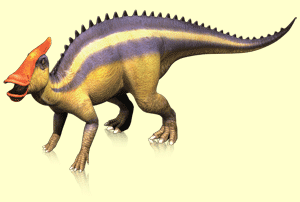
 
Brachylophosaurus pronounced /brəˌkɪləfɵˈsɔrəs/ brə-KIL-ə-fo-SAWR-əs or /ˌbrækiˌloʊfəˈsɔrəs/ brak-i-LOH-fə-SAWR-əs; meaning "short-crested lizard" (Greek brachys = short + lophos = crest + sauros = lizard, referring to its small crest) was a mid-sized member of the hadrosaurid family of dinosaurs. It is known from several skeletons and bonebed material from the Judith River Formation of Montana and the Oldman Formation of Alberta,[1] living about 76.5 million years ago.[2]
Contents[] |
[edit] Description[]
[1][2]Scale diagram comparing relative sizes of Brachylophosaurus and humansThis animal is notable for its bony crest, which forms a flat, paddle-like plate over the top of the skull.[3] Some individuals had crests that covered nearly the entire skull roof, while others had shorter, narrower crests.[4] Some researchers have suggested it was used for pushing contests,[5][6] but it may not have been strong enough for this. Other notable features are the unusually long forelimbs and the beak of the upper jaw being wider than other contemporary hadrosaurs.[3]
Apart from the above, Brachylophosaurus was a typical hadrosaur which reached an adult length of 9 meters (30 ft).[3] Like other hadrosaurs, Brachylophosaurus possessed features like cheeks to keep fodder in the mouth and dental batteries consisting of hundreds of teeth.[3] These teeth could be used to chew efficiently,[3] a feature rare among reptiles, but common among ornithischian dinosaurs like Brachylophosaurus.
In 2003, evidence of tumors, including hemangiomas, desmoplastic fibroma, metastatic cancer, and osteoblastoma was discovered in fossilized Brachylophosaurus skeletons. Rothschild et al. tested dinosaur vertebrae for tumors using computerized tomography and fluoroscope screening. Several other hadrosaurids, including Edmontosaurus, Gilmoreosaurus, and Bactrosaurus, also tested positive. Although more than 10,000 fossils were examined in this manner, the tumors were limited to Brachylophosaurus and closely-related genera. The tumors may have been caused by environmental factors or genetic propensity.[7]
[edit] Discovery and later finds[]
Brachylophosaurus was first described by Charles M. Sternberg in 1953 for a skull and partial skeleton which had been found in 1936, and at first thought to belong to Gryposaurus (or Kritosaurus as it was known at the time).[8] This remained the only described specimen until the 1980s, when Jack Horner described B. goodwini in 1988. This species was found in the Judith River Formation of Montana.[9] Later work indicated that the differences were probably not enough to justify the second species, and that some of the perceived differences were due to a misoriented skull bone.[4] Brachylophosaurus has subsequently become better known from fossils found in Montanta than Alberta, despite its species name canadensis.
[3][4]Ventral view of the skull and neck of "Leonardo"In 1994, amateur paleontologist Nate Murphy discovered an immaculate, complete and uncrushed brachylophosaur skeleton which he nicknamed "Elvis".[10] More impressive finds lay ahead for Murphy and his team from the Judith River Dinosaur Institute. In 2000, "Leonardo", a fully articulated and partially mummified skeleton of a subadult brachylophosaur, was discovered.[11][12] It is considered one of the most spectacular dinosaur finds ever, and was included in the Guinness Book of World Records.[13] They subsequently excavated "Roberta", an almost complete gracile skeleton, and "Peanut", a partially preserved juvenile with some skin impressions.[14] In May 2008, Steven Cowan, public-relations coordinator at the Houston Museum of Natural Science, discovered a Brachylophosaurus skeleton subsequently dubbed "Marco" from the same area as Leonardo.[15]